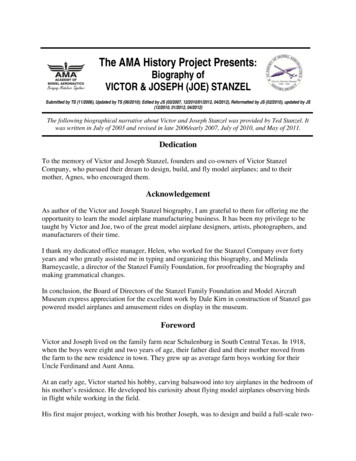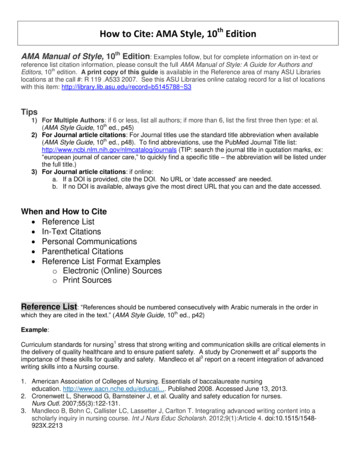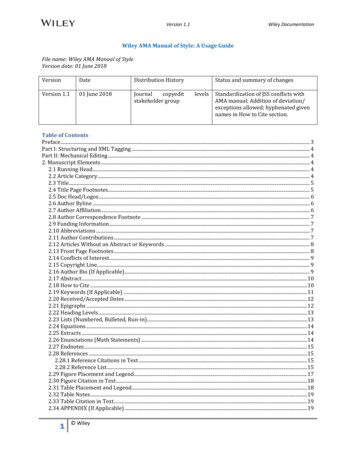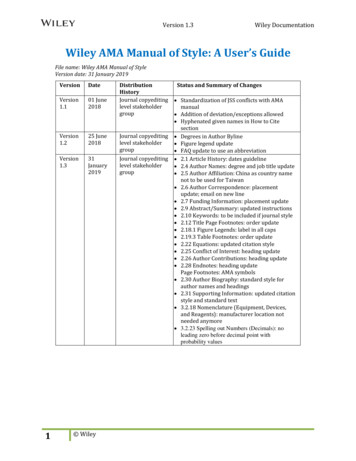
Transcription
The AMA History Project Presents:Biography ofVICTOR & JOSEPH (JOE) STANZELSubmitted by TS (11/2006), Updated by TS (06/2010); Edited by JS (03/2007, 12/2010/01/2012, 04/2012), Reformatted by JS (02/2010), updated by JS(12/2010, 01/2012, 04/2012)The following biographical narrative about Victor and Joseph Stanzel was provided by Ted Stanzel. Itwas written in July of 2003 and revised in late 2006/early 2007, July of 2010, and May of 2011.DedicationTo the memory of Victor and Joseph Stanzel, founders and co-owners of Victor StanzelCompany, who pursued their dream to design, build, and fly model airplanes; and to theirmother, Agnes, who encouraged them.AcknowledgementAs author of the Victor and Joseph Stanzel biography, I am grateful to them for offering me theopportunity to learn the model airplane manufacturing business. It has been my privilege to betaught by Victor and Joe, two of the great model airplane designers, artists, photographers, andmanufacturers of their time.I thank my dedicated office manager, Helen, who worked for the Stanzel Company over fortyyears and who greatly assisted me in typing and organizing this biography, and MelindaBarneycastle, a director of the Stanzel Family Foundation, for proofreading the biography andmaking grammatical changes.In conclusion, the Board of Directors of the Stanzel Family Foundation and Model AircraftMuseum express appreciation for the excellent work by Dale Kirn in construction of Stanzel gaspowered model airplanes and amusement rides on display in the museum.ForewordVictor and Joseph lived on the family farm near Schulenburg in South Central Texas. In 1918,when the boys were eight and two years of age, their father died and their mother moved fromthe farm to the new residence in town. They grew up as average farm boys working for theirUncle Ferdinand and Aunt Anna.At an early age, Victor started his hobby, carving balsawood into toy airplanes in the bedroom ofhis mother’s residence. He developed his curiosity about flying model airplanes observing birdsin flight while working in the field.His first major project, working with his brother Joseph, was to design and build a full-scale two-
seat aircraft, which was completed and patented in 1933.The second major project was a full-scale rocket ship, the 20th Century Stratus Ship, completedand patented in 1937. Victor and Joe changed course in 1938 and designed gas-powered controlline models. Their first, the Tiger Shark, was completed in 1939. It was followed by a series ofdifferent model airplanes. They believed it was no longer popular to build gas-poweredairplanes. The brothers began designing ready-to-fly model airplanes, which continued until2001. Throughout the 1990s, until his death in 1997, Victor developed a control line electricairplane utilizing his patented monoline control system.Joseph and Victor Stanzel established the Stanzel Family Foundation in 1989, one year beforethe death of Joseph in July of 1990. The Board of Directors fulfilled the brothers’ mandate toconstruct the foundation building in Schulenburg and provide space for the Stanzel ModelAircraft Museum.The Foundation building and museums were opened in 1998. Subsequently, the Stanzel BrothersFactory Museum was established in the original factory building in 2005 and moved to itspresent site.The primary objectives of the Stanzel Family Foundation, Inc. are to provide educationalopportunities and to enhance the health and well-being of the residents of the Schulenburg andWeimar communities.-Theodore StanzelVictor and Joseph (Joe) Stanzel:A BiographyBirthplaceVictor, Reinhart, and Joseph (Joe), the three sons of Edwardand Agnes Stanzel, were born on their family’s 90-acrefarm, one mile east of Schulenburg, Texas, along Highway90.Victor was born on January 23, 1910, Reinhart on August23, 1914 and Joe on November 29, 1916. Their parentsworked the land until their father, Edward, passed away in1918. There was no one to perform the physical labor, sotheir mother moved the family into a newly constructedresidence at 1201 Lyons Avenue in Schulenburg, across thestreet from Saint Rose Catholic Church. The family wasRoman Catholic; their mother taught the boys a sense ofdedication and adherence to Catholic teachings. They wereenrolled in St. Rose Parochial School, were taught by nuns,and learned to serve as altar boys.C. 1917: Victor Stanzel (back); JoeStanzel (left) and Reinhart Stanzel
The “new” Stanzel residence, constructedin 1919, adjacent to St. Rose RomanCatholic Church.Life on the FarmThe Stanzel residence (“Farm Home”),birthplace for Victor and Joe Stanzel.In their early years, the boys remained closeto farm life under their Uncle Ferdinand’ssupervision (their father’s brother), whoworked the 100 acres adjacent to their home.The boys’ grandparents, Franz and RozinaStanzel, who arrived from Austria in l873,owned the land. Victor and Joe receivedfatherly advice and guidance from their“Uncle Ferd.” They helped him plow, plantand harvest cotton and corn, milk cows andfeed the animals.They learned early in life that farming required hard work and long hours. One can be sure theirexperiences taught them discipline and a strong work ethic that remained a guiding forcethroughout their career in model aviation.When Victor was in his teens, in the mid-1920s, prospects were limited for a creative-mindedyoung man. He had no funds to attend a University and the country’s economic conditions werepoor.Victor had a curious mind, especially about airplanes and birds, which he observed flyingoverhead as he worked in Uncle Ferd's cornfield. He watched birds gliding, flapping their wingsand banking turns as they changed direction in flight. He was curious to learn the flying habitatsof birds and their ability to maneuver through the sky. He was also mesmerized by World War Iairplanes from the San Antonio Army Air Base out on cadet training missions, flying overSchulenburg’s skies. The airplanes they piloted were like the models he would soon begin tosketch, then draw to true scale and construct solid ornamental models from balsawood.Victor did not attend high school, which was normal for the majority of farm boys. He realizedhe was not technically educated to accomplish his dream, to design and build large amusement
park rides and games. He was 15 years of age when he successfully completed correspondencecourses in drafting, mechanical drawing, Algebra II, physics and practical mathematics throughthe American School in Chicago. In 1927, at 16 years, he continued with courses in tool making,machine shop work, strength of materials and machine shop management.True Scale ModelsIn the early 1920s, Victor began hand carving true scaleornamental airplanes from solid balsa wood. Victor beganhis first commercial venture in the family residenceconstructing solid models of the 20-inch Curtis Falcon AC3. Finished models were sold to flight cadets training atKelly Army Air Force Base for twenty dollars. He learnedfrom trade magazines that there was strong competition forA Curtiss Falcon AC-3true-scale models. Victor knew he must finish each airplaneto perfection to out-sell the competition. His early discipline now began to reap benefits.Beginning in the mid 1920s, Victor subscribed to magazines such as Popular Aviation, ModelAirplane News (M.A.N.), Air Aces, and Aero Digest. He realized it was important to remainabreast of this relatively new field of aviation, as it intrigued him.Victor knew that, to be successful, advertising was important for his new career in modelaviation. In 1932 and 1933, he began to run advertisements of his true-scale ornamental modelsand kits in M.A.N., Popular Aviation, and Aero Digest.Joe's contribution to Victor's model airplane construction business was limited. Joe continuedfulfilling his responsibilities on the farm as he progressed through his high school years. He wasan exemplary student at Schulenburg High School, on the varsity athletic team for four years,and graduated in 1933. When he reached this milestone in his life, the time had come for Joe tocontribute full-time to Victor’s aircraft construction projects.In the early 1930s, Victor and Joe set up an assembly process. They manufactured the parts foreach airplane and packaged educational construction kits for modelers.Solid Model AirplanesVictor and Joe sold kits of solid model airplanes, like theones listed below: U.S. Army Curtis Hawk P-6-E U.S. Navy Curtis Goshawk U.S. Army Boeing P12-E U.S. Navy Boeing F4-B4 Gee Bee Sportster Curtis Falcon AC-3 Curtis Hawk P-361932: This full-sized airplane,called the Fly-A-Plane, wasdesigned and built by Victor andJoe Stanzel.
A total of 14 different solid model kits were produced, which consisted of seven airplanes ofvarying sizes and wingspans. In 1931, Victor and Joe hired two employees to manufacture theirkits and sell them by mail order.As early as 1929, Victor made plans to expand the business beyond true scale construction kitsby developing full-scale amusement park attractions. Joe was only a freshman at SchulenburgHigh School. Victor, 19 years old, prepared for the coming challenges by enrolling in refreshercorrespondence courses in aircraft design and drafting. He read books and science magazines togain knowledge required to build a passenger carrying aircraft.The first major project was the design and construction of a full-sized electric powered airplane,modified as an amusement ride. He named it the “Fly-A-Plane Amusement Ride.” The aircraftconsisted of a two-passenger conventional high-wing cabin-type airplane, attached to one end ofa supporting beam, mounted on a stand-like support that allowed the beam to revolve with theairplane. When completed in 1932, they stationed it along a well-traveled road near town andoffered rides for twenty-five cents. Joe served as pilot of the aircraft.Later, it was located in a Houston park and eventually sold to an amusement park in Kilgore,Texas. Victor received his first patent for the “Fly-A-Plane Amusement Ride” in December of1933.After graduating from high school in 1934, Joe joined his brother in the business as co-partner.The manufacturing of true scale kits continued as design and construction of amusement ridesprogressed.The sale of model airplane construction kits required an expanded work force to manufacture andmarket the products. The different scale models increased to fourteen kits in the 1930s.Amusement RidesVictor's first major accomplishment in passenger aircraft design was an engineering success. Itinspired him to design an unconventional Buck Rogers rocket ship amusement ride, which hecalled the “20th Century Stratos-Ship.” The company required manufacturing space to proceed.In 1935, Victor and Joe constructed a small wood frame, 30-foot by 60-foot factory building.1936: This six-passenger, rocket-like ship,the Stratos-Ship, was designed and built byStanzel brothers and Emil Barborak.Victor and Joe, with associate Emil Barborak,established Stanzel-Barborak & Company.Together they completed the six-passenger rocketlike ship, mounted on a common axis that couldrotate, and revolved in an angular plane. Propelledby a five horsepower electric motor, the StratosShip whirled, spun, and looped with passengersexperiencing a thrill of their life.
The “Stratos-Ship” was completed in 1936. Itwas an immediate success at the 1936 TexasCentennial in Dallas, the Great LakesExposition in Cleveland, Ohio, and the NewYork World's Fair.Victor and Joe completed their thirdamusement ride in 1940. It consisted of four1940: The Stanzels’ amusement park ride, thepropeller-driven ships, each connected to theG-Ride, had four propeller-driven shipsend of a hanger. An electric motor rotated thepowered by an electric motor.propellers, causing the support structure,hanger, and ship to rotate as a unit above thespindle. The brothers received a U.S. patent for this ride in April of 1941.Game Playing DeviceVictor began designing an amusement apparatus, or gameplaying device, which consisted of a framed box with acurved bouncing plate and scoreboard. Magnetic ballsdropped from an upper position onto the bouncing plate andinto the scoreboard. The game was successfully completedbut never marketed. The U.S. Patent Office issued a patent in1941.G-Line Control AircraftAn amusement game-playingdevice with magnetic spheresand scoreboard, designed byVictor Stanzel.In 1939, Victor and Joe began phasing out the business of aircraft amusement rides andamusement games. They proved their design capability and engineering construction expertise inthe field of unconventional amusement rides and games. Even so, the ten-year venture provedonly marginally successful. It proved to be an important learning experience; it greatly boostedtheir can-do attitude. They were determined to move ahead into yet another aeronauticallyrelated business venture.It was challenging for Victor and Joe to forge ahead during theDepression. As hard times continued, and the winds of WorldWar II in Europe and the Far East gained momentum, thebrothers launched a new and unique business. They begandesigning engine-powered model aircraft, which continuedthroughout the 1940s and 1950s.1939: Joe holding the TigerShark, the first gas-poweredControl Line model airplanemarketed as a kit.The brothers formed aunique partnership thatcontinued for sixtyyears. Victor and Joewere equally responsible
for the company’s success in the design and manufacture of aircraft-related products. Victor wasthe ideas-man and Joe became a highly skilled craftsman-machinist and manager. Theircombined knowledge and artisanship enabled the company to contribute not only many uniqueideas, but also high quality products and marketing success. Victor was a man of many talentsand abilities. He designed model airplanes with precision and attention to detail. Joe was abuilder-flyer and possessed unique mechanical capabilities, even without a post-high schoolformal education.Together, they produced the Tiger Shark, their first Control Line gas-powered commercial kit.The kit was advertised in the December 1939 issue of Model Airplane News, under the tradename G-Line Flying. The Tiger Shark established their distinction as producing the firstcommercial Control Line engine-powered model aircraft kit.An application to patent controls for miniature airplanes, covering the new method of flying apowered model airplane by a control line, was filed November 6, 1939 and issued March 25,1941.The Tiger Shark model was flown with a single control line (“Guide Line”), approximately 50feet long. The airplane was controlled by attaching one end of the control line to the tip of anoutrigger, fixed forward of the leading edge of the wing, and attaching the other end to the tip ofa control pole. By moving the tip of the control pole up and down, applying pressure about thecenter of gravity, the airplane could nose up and down,climbing and diving in flight. The pole method developedinto a bit of humor as readers commented that the brotherscould not catch any fish, therefore used their fishing poles tofly model airplanes.During the 17 years following the amusement ride-era, thebrothers designed and constructed 18 unique engine poweredaircraft models for Control Line and Free Flight. The designchanges in each ensuing model incorporated featureadvancements for yet more Control Line systems designedand manufactured by Victor Stanzel and Company.Four unique Control Line systems to control models in flightwere invented and manufactured by Victor and Joe. The firstmethod of controlling an engine powered model airplane wasG-Line single line control, installed in the Tiger Shark. The1939 Tiger Shark was the first of l8 models designed by Victor,and the first single Control Line model kit ever made availablefor the model builder. Advertisements for the Tiger Shark,Baby Shark, and Texas Ranger G-Line Control kits came out inthe 1941 and 1942 issues of Toys and Novelties magazine.1940: A Texas Ranger, acombination Free Flight and Gline model kit with a 45-inchwingspan.1943: The big Tiger Sharktarget airplane is “crankedup” by Victor. Designed formilitary gunnery practice, itwas test-flown from themounting on a 1942Chevrolet.
First Phase: G-Line Flying AirplanesSix unique models were designed for G-Line single line control:DateDecember 1939March 1940November 1940March 1941March 1941March 1941AirplaneTexas SharkTexas RangerBaby SharkShark P-60Shark P-60Shark 6"24"Two Free Flight models were designed and manufactured as kits:DateMarch 1940July 1941AirplaneTexas ental Target AirplaneThe Big Tiger Shark target airplane was designed and built in 1943. At the time, Victor and Joewere employed by Kelly Field Civil Service. The airplane measured five feet between wing tips,and was five feet long. It was large so it could fly in a large circle and carry controls to make theairplane, which was carrying a Herkimer OK twin-powered engine, climb, and dive. The steeltube pylon, used to hold the airplane, was mounted on an automobile; Army Air Force gunnersshot at the live, unmanned, moving target as training.Second Phase: Roller Control AirplanesThe second phase of engine powered Control Line was a two-line control system, named “RollerControl.” It was the brothers’ first two-line control invention, and was manufactured andmarketed by Victor Stanzel & Company. The control system consisted of a handle with two linesattached to a bell crank assembly. The lines moved a pushrod to activate the elevators, allowingthe airplane to ascend and descend in-flight.DateDecember 1941December 1943January 1945AirplaneSuper–G SharkSuper-V SharkBaby-V SharkEngineB&CB&CA&BWingspan24"24"20"Third Phase: Control-It and Thum-It AirplanesThe third, post-World War II phase of airplanes utilize two-line control systems, which the
Stanzels called “Control-It,” and used a control handle, or “Thum-It.”DateMay 1947July 1947AirplaneShark G-5SharkadetEngineCCWingspan30"30"Monoline Control FlyingJim Walker patented the widely accepted two-line “U-Control” system about six months afterVictor came out with his 1939 "G-Line" single-line control system. Both Stanzel and Walkersystems had faults: they could cause a serious lack of control problem during flight. If the linesbecame slack because of windy conditions, there was no control given to the bell crank andelevators. In 1948, Victor and Joe began developing a unique control system called monoline, orsingle line control.Monoline flying revolutionized Control Line Speed flying in 1950. It was an entirely new era ofPrecision Acrobatic Stunt and Combat flying, utilizing the medium of the Stunt-Master controlunits. The new system of Control Line flying was perfected through more than 12 years ofexperimental research and development. The brothers tried many different devices ormechanisms to solve the problem of loss of elevator control due to slackened lines.The principle involved the transmission of torque through a solid steel control line to activate acontrol unit (cam) on the model, which in turn moved a push rod back and forth to the elevatorhorn. A special control handle applied the torque to the control line and a sliding control knobactuated it, which is moved "back" for "up" and "forward" for "down" in a manner similar to realaircraft controls.Specific Monoline control units were designed and adapted for model aircraft to achievedifferent flying objectives. The 1/2A and ABC engine-powered Monoline control units wereadapted for Sport and Trainer models. The Speed-Master control unit was adapted for Class1/2A, A, B, C and jet aircraft. The Stunt-Master control unit wasadapted for Aerobatic, Combat, Scale and Sport models in the1/2A, A, B, and C classes.Each Monoline control unit was a forerunner of improvedMonoline control systems. In June of 1950, they designed theTuffy airplane, the first of five Monoline kits marketed by VictorStanzel & Company.1950: Tuffy, the first ofVictor and Joe introduced Monoline control flying to thefive Monoline control kitsdesigned by Victor andmodeling world at the Chicago Hobby Model Trade Show inJoe.1950. They submitted a patent application on March 9, 1945 andwere issued patent on "Single Line Control for MiniatureAircraft" on June 26, 1951. (All the Monoline airplanes, control units, handles, and linesmanufactured by Victor Stanzel & Company are displayed in the Stanzel Model AircraftMuseum in Schulenburg, Texas.)
Monoline Control AirplanesDateJune 1950August 1954August 1954August 1954May 19551954AirplaneTuffyABC Trainer1/2A TrainerLil’ RaiderSky RaiderLil' Rocket (Ready-to-Fly)EngineHerkimer .074 or.099.19 to .351 - 2A1 - 2AA-B-C0.049Wingspan24"36"18"24"40"15"Monoline Speed AirplanesThe Stanzels began designing Speed models for their Monoline control systems in 1950. In 1951,they demonstrated their Speed model, Tuffy, on the parade grounds at Fort Sam Houston in SanAntonio. It was there they met Dale Kirn, a member of the U.S. Air Force and an avid modelbuilder and flyer.On subsequent visits to San Antonio, Monoline Speed airplaneswere flown to the delight of modelers there. As Dale indicated,"Victor flew the Speed airplane with a McCoy .29 at speeds thatwere the best he ever saw.” Dale became a happy recipient ofMonoline control unit and handle. The 8443, an .049 enginepowered Monoline Speed airplane flown by Dale, set an officialAMA Speed record of 100.89 mph. It was flown on a .010diameter, 35-foot steel line.At a 1954 Dallas contest, Dale set Speed records with his ClassA Speed airplane equipped with the Stanzel's Monoline controlsystem. He set the first two AMA Speed records, 134.68 mphand 154.98 mph.The brothers organized a Monoline promotional tour in March1955. They hired Dale and Bill Murry to travel across the U.S.,demonstrating Monoline flying at model airplane contests,hobby shops, and model airplane clubs. Dale demonstrated theunique features of Monoline and Bill did the marketing.Era of Ready-to-Fly Airplanes1957: Open Championtrophy, MonolineControl Line event, EastDallas Exchange ClubSouthwest ModelAirplaneChampionships, won byClem-Beasley-Kirn.
The brothers’ engine-powered Control Line model aircraft phase ended in 1957. Theycontemplated a significant change in their product line, as they perceived a curtailment of publicinterest for Control Line flying, both two-line and Monoline control. They observed that enginepowered model aircraft flying presented a noise problem; they wanted to reduce or eliminate thatproblem.Dedicated employees assembled flyingtoys for more than forty years.1958-1996: Assorted Ready-to-Fly toysdesigned and manufactured by Victor and Joe.Victor and Joe envisioned that times were changing and less attention would be given to "buildyour own" kits so prevalent in the 1940s. The time was right to build and assemble airplanes inthe factory, place them in an attractive box and market the product as a “Ready-to-Fly” toy.They began to design Ready-to-Flies by incorporating an electric motor and dry cell batteries asthe new power source. Focus was on developing the toys for children ages six and above.They designed and produced a new series of toy airplanes. The airplanes were attached at the endof a cable, which transferred battery power to the model. The toy was approximately seven feetfrom the flight operator and flew in a circle overhead. A second and uniquely different flying toywas the Free Flying Trigger Jet. It was launched by a spring-loaded, trigger-released launch gun.The brothers fueled their toy business for the next forty years with 33 different toy ideas anddesigns, all aeronautic in concept, and possessing the capability to fly fast. The primary objectivewas to produce a flying toy that was well-constructed, safe for children, had a low noise level,and contained features that made the toy lift and fly just like a real airplane.A chronological list of toys that the brothers designed, manufactured, and marketed from 1958 tothe end of the 20th century follows: Electromic Flash (1958) - Conventional high-winged airplane; battery-powered, remotepush-button controlled by a patented torque control system; tethered and flies above theoperator. Electromic Jet (1959) - Prop Jet flying model; battery-powered; remote push-buttoncontrolled; tethered and flies above the operator. Electromic Scoot Air Car (1960) - Battery-powered; remote push-button directionallycontrolled; tethered and rides on a low-pressure cushion of air six to twelve inches above
surfaces. Electromic Dart (1960) – Speedboat; battery-powered with "magic wand”; push-buttoncontrolled. Sonic Jet (1961) – Tethered, adjustable-length Control Line flyer; flies by swing power;sounds like a real jet in flight. Electromic Helicopter (1962) - Battery-powered; push button;remote controlled; tethered; takes off, hovers, lands and doesrescue operations; comes with two astronaut figures. Aero-Jet Streak (1963) - World's finest Ready-to-Fly, pureFree Flight jet, propelled by a Tru-Jet motor charged withZOOM (a non-flammable propellant gas.) Tru-Jet Whiz (1964) – Jet-propelled racecar, powered by agas-pressurized Tru-Jet motor fueled by push-button controlwith ZOOM. Electromic Fury (1965) - Balloon "bursting" flying modelstunt airplane; tethered; battery-powered; push-buttoncontrolled; flies into and bursts targeted balloons. Electromic Wild Cat (1966) - Ferrari racecar; new “U-Drive”; freewheeling; Speed-linebattery-powered control. Electromic Lunar Bug (1967) - Flying moon craft and space game, battery-powered andpush-button controlled. Electromic Astro-Jack (1968) - Flying space boy and space station; battery-powered,remote push-button controlled; play a game of space, take off and land Astro Jack aboardthe space station as he rolls and tumbles in space.1969: The Flash-Copter FlyingCombo, in original packaging.1986: Victor takespride indemonstrating hisoriginal helicopter,invented in 1962. Electromic Flash-Copter Flying Combo (1969) Interchangeable power pack control handles;powered with two D batteries; push-buttonremote controlled; comes with two astronautfigures for helicopter rescue operations. Electromic Astro Jack-Lunar Bug Space Combo(1969) - Came with flying space boy and flyingmoon craft; interchangeable power pack controlhandle; play a game of space with the weightlessAstro Jack; fly the lunar bug to the moon; playmoon landing space games.
Mini Jet Dart (1970) - Real jet-propelled airplane with tricycle landing gear; buttoncontrolled; powered by ZOOM. Mini Rocket Hawk (1970) - Ready-To-Fly rocket with launch stand; powered by ZOOM. Mini Jet "505" (1970) - Jet propelled flying airliner; Ready-to-Fly; push-button control;propelled by ZOOM. Dyna-Jet Whiz (1971) Trigger Jet Plane (1972) - Free Flight airplane with trigger release, spring-poweredlaunch gun. Swinger (1972) - Free Flight Stunt airplane with rubber band catapult launcher; swingpowered swing line; catapult free-line stunt flying. Electromic Lil’ Rascal (1973) - Stunt master biplane with new push-button stunt mastercontrol handle and secondary control knob. Re-introduced the Scoot (1975) Trigger Jet Plane (1976) - Free Flight model airplane with spring powered launch gunand trigger release, Yankee Doodle Dandy depicting the Spirit of 1776. Repackaged the Bug to the Star Bug; new packaging on the Helicopter, Lil’ Rascal andElectromic Jet.(1978) Electromic Gyro (1979) - Real flying model gyroplane (historic forerunner of thehelicopter), battery-powered, push-button controlled. Shooting Star (1980) - Free Flight space ship with trigger-release; spring-powered launchgun. Electromic Star Raider (1980) - Flying space fighter model airplane; enemy satelliteblaster; battery-powered; push-button remote control. Space Shuttle (1981) - Free Flight rubber bandcatapult launched, in a blister package. Electro-Jet F-2000 (1985) - Jet propelled fightermodel airplane; remote-powered; turbo-jet propelledairplane; real jet sound. Trigger Jet Stealth (1987) – Free Flight fighter modelairplane with trigger-release, spring-powered launch1958-1996: Assorted Readyto-Fly toys, designed, andmanufactured by Victor andJoe.
gun. Electromic Stealth (1987) - Strategic fighter model airplane; canard design; batterypowered push-button; remote-controlled. Electromic Ziroids (1987) - Rotary model flying space toy with pilot; "Just in fromSpace”; vertical take-off; battery-powered push-button control launcher. Shooting Star (1991) - Free Flight model airplane; four hot color assortments; rubberband launcher. Space Shuttle (1994) - Free Flight model of a real space shuttle; white with officialNASA logo; trigger-released spring-powered launch gun.Marketing the ProductMarketing skills and techniques usually require professional training, but the Stanzels usednatural abilities to develop their marketing strategy. They possessed a unique ability to design,manufacture, and market a variety of products directed to different consumer bases. They wereinvolved in every step of the advertising process.During the 70-year history of the Victor Stanzel Company, Victor and Joe made major productchanges in the types of products they manufactured. Each modification in products changed theirconsumer base. In the 1930s, the company directed manufacturing toward two objectives: (1)building true-scale ornamental models, and (2) manufacturing commercial rides for amusementparks.In the 1940s and 1950s, the company manufactured and sold gas-powered model airplanes andcontrol systems to modelers. In 1958, the last major change took place with the advent of Readyto-Fly toys. The end use customers quickly changed to 6- to-15-year-old boys and girls, incontrast to the mature older model builders in the 1940s and 1950s. Consequently, the Stanzelshad to focus on their marketing strategies.The earliest marketing effort by Victor
Victor and Joseph (Joe) Stanzel: A Biography Birthplace Victor, Reinhart, and Joseph (Joe), the three sons of Edward and Agnes Stanzel, were born on their family’s 90-acre farm, one mile east of Schulenburg, Texas, along Highway 90. Victor was born on January 23, 1910, Reinhart on Au









